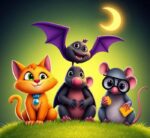- You are here:
- Home »
- words
- » Easy Words That Start With T [LIST]

Easy Words That Start With T [LIST]
Finding simple words that start with the letter ‘T’ can be a helpful and fun exercise, whether you’re learning a new language, expanding your vocabulary, or looking for words to use in creative writing. The letter ‘T’ is one of the most common starting letters in English, and it is packed with easy-to-understand words. From everyday objects to essential verbs, there are countless options that are both practical and easy to remember. This list can serve as a great starting point for beginners or anyone wanting to improve their language skills in a fun and engaging way.
In this article, we will explore a collection of easy words that start with ‘T’ that are perfect for all ages. These words are simple, yet rich in meaning, and can be used in a variety of contexts. Whether you’re teaching young learners, expanding your own vocabulary, or simply looking for words that are easy to spell and pronounce, this list will provide you with a wide range of options to suit your needs. From common nouns to easy action verbs, these words can help enhance your language skills while keeping things light and accessible.
Easy Words That Start With T
1. table
A table is a flat surface supported by legs, commonly used to hold items, eat, or work on. Tables come in various shapes and sizes.
Examples
- I placed the book on the table.
- She set the plates on the dinner table.
- The table in the kitchen is made of wood.
2. tree
A tree is a large plant with a trunk, branches, and leaves. Trees can be found in forests, parks, and backyards and are important for the environment.
Examples
- The tree in our yard has beautiful flowers.
- We climbed the tree to get a better view.
- In the autumn, the tree’s leaves turn yellow.
3. train
A train is a large vehicle that runs on tracks and is used for transporting people or goods over long distances.
Examples
- The train arrives at 9 AM.
- She took the train to the city.
- We boarded the train for a long journey.
4. teacher
A teacher is a person who educates or instructs students, usually in a school setting. They help students learn new information and skills.
Examples
- The teacher explained the math problem.
- Our teacher gave us a project to work on.
- She is a kind and patient teacher.
5. tiger
A tiger is a large carnivorous animal found in Asia. Known for its strength and orange coat with black stripes, the tiger is an apex predator.
Examples
- The tiger roams the jungle freely.
- Tigers are powerful and fast animals.
- We saw a tiger at the zoo yesterday.
6. towel
A towel is a piece of cloth or fabric used for drying oneself or something, typically after bathing or washing.
Examples
- She dried her hair with a towel.
- The hotel provided us with clean towels.
- I need a towel to wipe the spilled water.
7. toy
A toy is an object that children play with, designed for entertainment and fun. Toys can be anything from dolls to puzzles.
Examples
- The children played with their new toys.
- She bought a toy car for her brother.
- My favorite toy was a stuffed bear.
8. telephone
A telephone is a device used to communicate with people over long distances by transmitting sound, such as voice.
Examples
- She called her friend using the telephone.
- I couldn’t hear you clearly on the telephone.
- He uses the telephone for work.
9. thunder
Thunder is the loud sound that occurs after a lightning strike, caused by the rapid expansion of air due to heat.
Examples
- We heard thunder during the storm.
- The thunder was so loud that it woke me up.
- I love the sound of thunder during a rainstorm.
10. turtle
A turtle is a slow-moving reptile known for its hard, protective shell. Turtles can live on land or in water.
Examples
- The turtle slowly crawled across the sand.
- Turtles are known for their hard shells.
- We saw a turtle in the pond during our hike.
11. tomato
A tomato is a red or yellow fruit that is typically used in salads, sauces, or soups. Although it is botanically a fruit, it is commonly used as a vegetable in cooking.
Examples
- I added a tomato to my sandwich.
- Tomatoes are a key ingredient in many sauces.
- We grew tomatoes in our garden this summer.
12. television
A television is a device used to watch shows, movies, and other video content. It can be used for entertainment, news, or education.
Examples
- I watched my favorite show on television.
- The television was on in the background while we ate.
- He sat in front of the television for hours.
13. toast
Toast is bread that has been browned by heat, often eaten as a snack or part of a meal. It is commonly served with toppings like butter or jam.
Examples
- She spread butter on her toast.
- I like to eat toast with jam for breakfast.
- The toast was perfectly golden brown.
14. tough
Tough refers to something that is strong, durable, or difficult to break. It can also describe a person who is resilient or hard to defeat.
Examples
- The steak was too tough to cut.
- She gave a tough answer to the difficult question.
- His tough attitude helped him succeed in challenges.
15. trip
A trip is a journey or excursion from one place to another, typically for leisure, business, or travel.
Examples
- We are planning a trip to the beach next week.
- He had a trip to the mountains last summer.
- She took a short trip to the store.
16. thick
Thick refers to something that has a large width or depth. It can describe physical objects or substances that are dense or compact.
Examples
- The book has thick pages.
- He wore a thick coat because it was cold.
- The fog was so thick that we couldn’t see clearly.
17. temperature
Temperature refers to the measure of heat or coldness of an environment, substance, or object. It is often measured in degrees.
Examples
- The temperature outside is very cold today.
- She checked the temperature of the water.
- The temperature in the room was too high.
18. treat
To treat means to give something special to someone or to care for them. It can also refer to a special gift or action.
Examples
- She gave the dog a treat for being good.
- We decided to treat ourselves to some ice cream.
- He was treated with kindness during his stay.
19. twin
A twin is one of two children born to the same mother at the same time. Twins can be identical or fraternal.
Examples
- The twins look exactly alike.
- She has a twin brother who is very tall.
- They celebrated their birthday together as twins.
20. turn
To turn means to rotate or change direction. It can also refer to taking a turn in a sequence of actions or events.
Examples
- It’s your turn to speak now.
- The road turns left at the corner.
- I had to turn the key to start the car.
21. ticket
A ticket is a small piece of paper or electronic document that allows you to access an event, transport, or service.
Examples
- He bought a ticket for the concert.
- I lost my train ticket.
- You need a ticket to enter the amusement park.
22. tropical
Tropical refers to regions of the world that are near the equator, characterized by hot and humid weather and rich vegetation.
Examples
- The tropical climate is hot and humid.
- We visited a tropical island last year.
- Tropical plants like palm trees grow in warm climates.
23. thumb
The thumb is the first and shortest finger on the hand, located on the side of the hand, and is often used for grasping or pointing.
Examples
- She gave a thumbs up to show approval.
- I accidentally hurt my thumb while hammering.
- He pointed with his thumb to the direction he was going.
24. top
Top refers to the highest point or surface of something. It can also describe the upper part of clothing, like a shirt or blouse.
Examples
- The book is on the top shelf.
- She wore a blue top to the party.
- He reached the top of the mountain after a long hike.
25. team
A team is a group of people who work together to achieve a common goal, often in sports, work, or projects.
Examples
- Our team won the soccer game.
- They worked together as a team to solve the problem.
- She is part of a basketball team at school.
26. taste
Taste refers to the sensation experienced when food or drink is consumed. It can also describe the flavor of something.
Examples
- This soup has a delicious taste.
- I don’t like the taste of spicy food.
- Her cooking has a unique taste.
27. tall
Tall describes something that has a great height, often used for people, buildings, or other objects.
Examples
- She is tall and can reach the top shelf.
- The tall building stood out in the city skyline.
- The tree is so tall it touches the sky.
28. together
Together means in the company of others or in a unified group. It describes actions or states where things or people are combined.
Examples
- We should work together to finish the project.
- The family gathered together for dinner.
- They live together in the same house.
29. time
Time is a measure of the passing of events, often measured in seconds, minutes, hours, and days.
Examples
- What time does the meeting start?
- She asked for the time during the trip.
- Time flew by while we were having fun.
30. tasteful
Tasteful means something that is elegant, aesthetically pleasing, or in good taste.
Examples
- She decorated her room in a tasteful manner.
- The party was organized in a tasteful way.
- He has a tasteful choice of clothing.
31. tune
A tune is a melody or musical composition, often simple and pleasant to listen to.
Examples
- The music was playing a cheerful tune.
- She hummed a tune while walking down the street.
- The piano was out of tune and needed adjusting.
32. tail
A tail is the long, flexible part at the back of many animals, often used for balance or communication.
Examples
- The dog wagged its tail happily.
- The cat has a long tail.
- The airplane’s tail was visible from far away.
Historical Context

The letter "T" holds an important place in the evolution of language, especially in English, which is rich in borrowing and linguistic influences from a variety of languages. The prominence of words beginning with "T" can be traced back through historical and cultural shifts that shaped the English lexicon.
Historically, English is a Germanic language that evolved over centuries through the fusion of Old English (Anglo-Saxon), Norse, Latin, and French influences. The development of words beginning with the letter "T" reflects some of these external influences. For example, in the early Middle Ages, Norse invasions introduced a variety of Scandinavian terms into English. Many of these words—such as thrust, thing, and troll—can still be found today. Similarly, Latin, as the language of the church, education, and scholarship, contributed a substantial number of "T" words, especially during the Renaissance period when Latin was in widespread use in academic and religious contexts.
In terms of phonetics, the "T" sound itself has ancient roots. It can be traced back to Proto-Indo-European, the common ancestor of many European and South Asian languages. Words that share this sound have carried through millennia, often adapting and morphing into forms recognizable in modern English. As English spread across the world through the expansion of the British Empire, the influence of other cultures and languages further enriched the language with new "T" words.
Word Origins And Etymology
The etymology of words starting with the letter "T" reveals a fascinating blend of diverse linguistic roots. Many of these words have complex histories, with origins in languages ranging from Old English to Latin, Greek, and beyond. The letter "T" itself is derived from the ancient Phoenician alphabet, which is the precursor to many modern alphabets, including Greek and Latin. The symbol for "T" in Phoenician resembled a cross or a mark that represented the concept of a "signature" or "mark," a function which persists in modern English in words like target or trace.
Some of the most common "T" words in English have their roots in Old English or Anglo-Saxon, including simple and everyday words like time, tree, and tide. For instance, time comes from the Old English tima, which was derived from the Proto-Germanic tīmaz, itself stemming from the Proto-Indo-European deh₃mos, meaning “to divide” or “to separate” – an early connection to the measurement of periods or intervals.
Many words starting with "T" in modern English were also influenced by Latin, particularly during the Renaissance when Latin was the lingua franca of educated Europeans. For example, television has roots in the Greek word tele, meaning “far,” and the Latin word visio, meaning “sight.” Similarly, transport is derived from the Latin word transportare, meaning “to carry across,” combining the roots trans- (across) and portare (to carry).
Moreover, with the expansion of the British Empire, numerous languages and cultures contributed to the English lexicon, particularly with the introduction of new foods, materials, and concepts. Words like tobacco (from the Spanish tabaco, which itself originated from the Arawakan languages of the Caribbean) and tea (from the Chinese te) reflect the influence of trade routes and colonial encounters.
Common Misconceptions
Despite their commonality and simplicity, many words beginning with "T" can be the subject of misunderstandings, both in terms of their meaning and usage. These misconceptions often arise due to the complex etymologies and historical transformations of the language.
One of the most frequent misconceptions is confusing the words their, there, and they’re. While these words sound the same, they each have distinct meanings and uses. Their is a possessive adjective indicating ownership, there is an adverb denoting a place or position, and they’re is a contraction of “they are.” Confusing these terms, particularly in spoken language, is a common mistake that can muddle communication. This can be especially tricky in written form, where the correct usage of these words can be a marker of careful attention to detail.
Another common confusion is between words like than and then. While both are pronounced similarly, than is used in comparisons (e.g., “I’m taller than you”), while then refers to time (e.g., “First we went to the store, and then we went home”). This mix-up occurs frequently due to the similarity in sound and the overlap in context, particularly in colloquial speech.
Moreover, words like tolerate and tolerant are often misunderstood in terms of their social and ethical connotations. Tolerate means to endure or put up with something, often implying a degree of passive acceptance. In contrast, tolerant describes an active and positive acceptance of differences, whether in terms of culture, beliefs, or lifestyles. The difference is subtle but significant, and understanding this distinction helps to foster more accurate communication, especially in discussions surrounding social issues.
Conclusion
In conclusion, the letter "T" occupies an essential and fascinating space in the world of language, particularly in English. The historical context of words beginning with "T" reflects centuries of linguistic evolution, shaped by influences from Old English, Norse, Latin, and other languages. This deep history contributes to the rich diversity of "T" words we use today, many of which carry significant meaning and varied connotations.
Etymologically, "T" words are a reflection of the interconnectedness of human societies, as words evolve through the blending of cultures, trade, and intellectual exchange. From the foundational sounds of Proto-Indo-European to the global influence of trade and empire, the origins of "T" words paint a picture of a language in constant flux, absorbing and adapting over time.
However, as common and accessible as many "T" words are, they are also prone to misunderstanding. The subtleties of their meanings, spellings, and usages are often overlooked, leading to common errors in both written and spoken English. Whether it’s the confusion of homophones or the misinterpretation of similar-sounding words, understanding the nuances of "T" words is essential for effective communication.
Ultimately, "T" words are more than just linguistic tools—they are windows into the past, reminders of cultural exchange, and carriers of meaning in the modern world. By appreciating their origins, histories, and occasional pitfalls, we can enrich our understanding and use of language in deeper and more meaningful ways.








